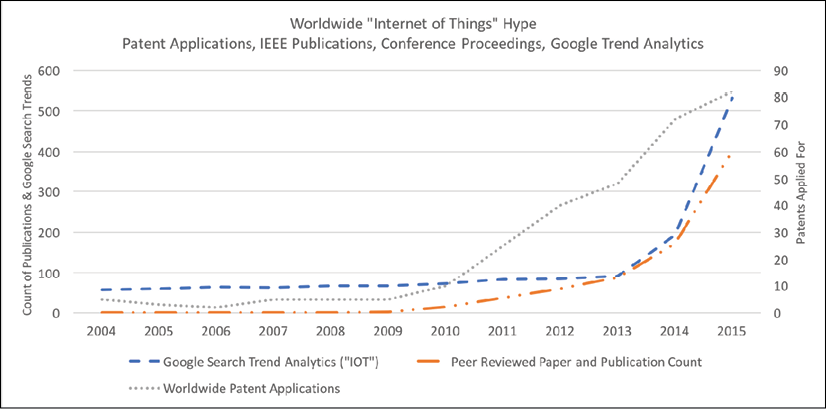History of the IoT
The term "IoT" can most likely be attributed to Kevin Ashton in 1997 and his work at Procter and Gamble using RFID tags to manage supply chains. The work brought him to MIT in 1999 where he and a group of like-minded individuals started the Auto-ID Center research consortium (for more information, visit http://www.smithsonianmag.com/innovation/kevin-ashton-describes-the-internet-of-things-180953749/).
Since then, IoT has taken off from simple RFID tags to an ecosystem and industry that will have 1 trillion Internet-connected devices by 2030. The concept of things being connected to the Internet up through 2012 was primarily connected smartphones, tablets, PCs, and laptops. Essentially, things that first functioned in all respects as a computer. Since the humble beginnings of the Internet, starting with ARPANET in 1969, most of the technologies surrounding the IoT didn't exist. Up to the year 2000, most devices that were associated with the Internet were, as stated, computers of various sizes. The following timeline shows the slow progress in connecting things to the Internet:
| Year | Device | Reference |
|
1973 |
Mario W. Cardullo receives the patent for first RFID tag. |
US Patent US 3713148 A |
|
1982 |
Carnegie Mellon Internet-connected soda machine. |
|
|
1989 |
Internet-connected toaster at Interop '89. |
IEEE Consumer Electronics Magazine (Volume: 6, Issue: 1, Jan. 2017) |
|
1991 |
HP introduces HP LaserJet IIISi: the first Ethernet-connected network printer. |
|
|
1993 |
Internet-connected coffee pot at University of Cambridge (the first Internet-connected camera). |
|
|
1996 |
General Motors OnStar (2001 remote diagnostics). |
|
|
1998 |
Bluetooth Special Interest Group (SIG) formed. |
|
|
1999 |
LG Internet Digital DIOS refrigerator. |
https://www.telecompaper.com/news/lg-unveils-internetready-refrigerator--221266 |
|
2000 |
First instances of the Cooltown concept of pervasive computing everywhere: HP Labs, a system of computing and communication technologies that, combined, create a web-connected experience for people, places, and objects. |
|
|
2001 |
First Bluetooth product launched: KDDI Bluetooth-enabled mobile phone. |
http://edition.cnn.com/2001/BUSINESS/asia/04/17/tokyo.kddibluetooth/index.html |
|
2005 |
United Nation's International Telecommunications Union report predicting the rise of IoT for the first time. |
http://www.itu.int/osg/spu/publications/internetofthings/internetofThings_summary.pdf |
|
2008 |
IPSO Alliance formed to promote IP on objects, first IoT-focused alliance. |
|
|
2010 |
The concept of Smart Lighting formed after success in developing solid-state LED light bulbs. |
|
|
2014 |
Apple creates iBeacon protocol for beacons. |
Certainly, the term IoT has generated a lot of interest and hype. One can easily see that from a buzzword standpoint. The number of patents issued (https://www.uspto.gov) has grown exponentially since 2010. The number of Google searches (https://trends.google.com/trends/) and IEEE peer-reviewed paper publications hit the knee of the curve in 2013:

Figure 1: Analysis of keyword searches for IoT, patents, and technical publications




























































